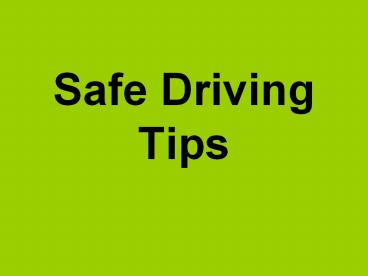Safe%20Driving%20Tips - PowerPoint PPT Presentation
Title:
Safe%20Driving%20Tips
Description:
... & braking Avoid Hydroplaning or Skidding Handling Weather Conditions - Hydroplaning: Release accelerator & keep a firm grip on the wheel. Handling ... – PowerPoint PPT presentation
Number of Views:293
Avg rating:3.0/5.0
Title: Safe%20Driving%20Tips
1
Safe Driving Tips
2
Safe Driving Tips
- Avoid Aggressive Driving
- - Speeding
- - Tail gating
- - Conflict
- Monitor Speed
- - Stopping time Distance
- - Road Weather Conditions (wind)
- - Vehicle conditions (brakes car size)
3
Safe Driving Tips
- Keep a safe following distance
- - 3 second rule
4
Night Driving
- Use headlights from dusk and dawn.
- Bright lights must be dimmed 500 feet before
meeting an oncoming vehicle or 300 feet before
passing a vehicle - Street lights cause
glare. - Signs are more
difficult to see at
night - Use Edge lines (white/solid) Center lines
(yellow/solid) to guide you
5
Practice
- 11. Within how many feet is a driver required to
dim the headlights before meeting another
vehicle? - a. 250 feet b. 400 feet c. 500 feet
6
Practice
- 12. Headlights must be lighted from sunset to
sunrise. True or False - 13.Your car must have a horn that can be heard
from a distance of 200 feet. True or False
7
Practice
- 14. When approaching a railroad crossing that has
no warning signals (such as electric flashing
lights or gates), a driver should look, listen
and slow down. - True or False
8
Practice
- 15. After a train clears a crossing that has
flashing signals, drivers may proceed after
checking for a second train on another track. - True or False
- 16. If moving with a stream of vehicles across a
railroad track, it is safe to stop on the track
for a short period of time. - True or False
9
WEATHER
10
Handling Weather Conditions
- RAIN
- Use headlights Wipers
- No cruise control
- Increase following
distance - More care on turns, curves, braking
- Avoid Hydroplaning or Skidding
11
Handling Weather Conditions
- - Hydroplaning
- Release
- accelerator
- keep a firm grip
- on the wheel.
12
Handling Weather Conditions
- Skid Release the
- accelerator
- turn the wheel in
- the direction of
- The skid.
- Never slam on the
- brakes.
13
Handling Weather Conditions
- Winter Driving
- Hardest weather to drive in
- Drive slow increase
following distance - Remove snow from car,
all windows, lights - Brake slowly to find
traction - Carry emergency supplies
14
Handling Weather Conditions
- FOG
- No cruise control
- Drive slow but not too
slow - Dim or fog lights
- Stay within vision
- Brake earlier use turn
signals ahead of time
15
Equipment Failure
16
Equipment Failure
- Blowouts
- Loud thumping sound
- Ease foot off gas pedal
(accelerator) - Keep a firm grip on
steering wheel - Do Not brake
- suddenly
- Pull slowly to the side
of the road
17
Equipment Failure
- Brake Failure
- Brake sinks to floor
- Pump to build pressure
- Use emergency brake if necessary
- Shift into a lower gear
18
Driving Off the Pavement
- Wheels drift off road onto shoulder
- May hear rumble strips
- Grip wheel firmly
- Take foot off gas pedal
- Brake soft /slow
- Check traffic
- Steer back onto pavement into the 1st lane.
19
Getting Pulled Over
- Be aware you might have done something wrong
- If you want to explain, do so before Officer
returns to their car before ticket is written - If you feel you are unfairly treated, report the
Officer - Officers are required to give
their names badge numbers
20
Practice
- 1.The road surface of a bridge may be dangerous
in winter because it may remain icy after the
rest of the roadway is clear.True or False - 2. If driving during foggy weather, a driver
should turn on the vehicles high-beam headlights
to increase the field of vision.True or False
21
Practice
- 3. Most rear-end collisions are caused by the
vehicle in back traveling too closely.True or
False - 4. The three-second rule helps the driver
determine a safe following distance.True or
False - 5. If a vehicle starts to skid on water
(hydroplane), the driver should quickly apply the
brakes.True or False
22
Practice
- 6. If the front right wheel of a vehicle runs off
the pavement, a driver should ease off the
accelerator, brake gently and gently steer back
onto the pavement.True or False - 7. When approaching a railroad crossing that has
no warning signals (such as electric flashing
lights or gates), a driver should look, listen
and slow down.True or False
23
Practice
- 8. After a train clears a crossing that has
flashing signals, drivers may proceed after
checking for a second train on another
track.True or False - 9. If moving with a stream of vehicles across a
railroad track, it is safe to stop on the track
for a short period of time.True or False
24
Practice
- 10. Drivers who become stranded in blizzard
conditions should remain in their vehicles.True
or False - 11. When experiencing a tire blowout, the driver
should apply the brakes quickly and pull off the
roadway to check the tire.True or False
25
Practice
- 12. If a vehicle starts to skid, the driver
should gently apply the brakes and steer in the
opposite direction of the skid.True or False - 13. Illinois law requires that headlights be
illuminated when atmospheric conditions require
the use of windshield wipers.True or False































